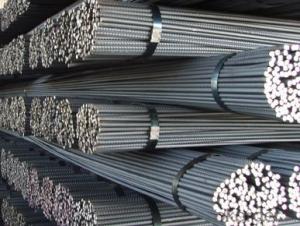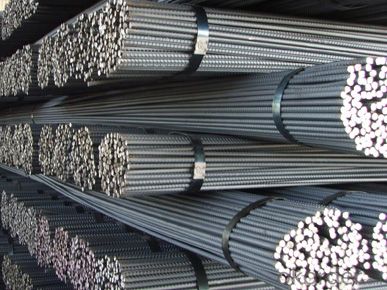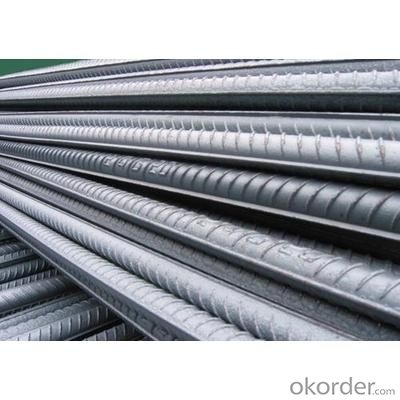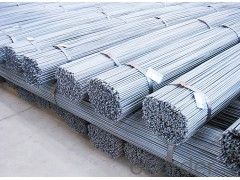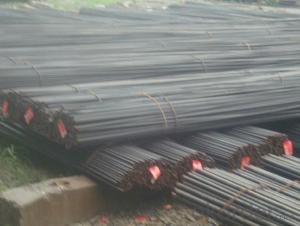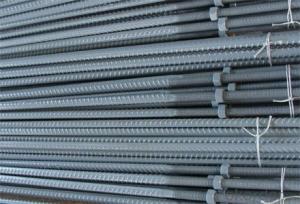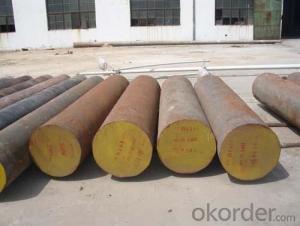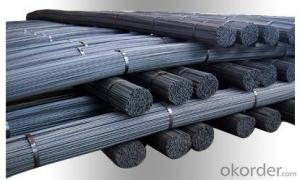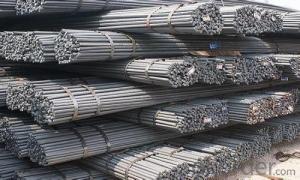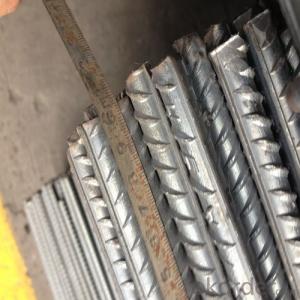GR40 deformed steel bar for construction made in China
- Loading Port:
- Tianjin
- Payment Terms:
- TT OR LC
- Min Order Qty:
- 25 m.t.
- Supply Capability:
- 100000 m.t./month
OKorder Service Pledge
OKorder Financial Service
You Might Also Like
Usage and Applications of Deformed Steel Bar:
Deformed bar is widely used in buildings, bridges, roads and other engineering construction. Big to highways, railways, bridges, culverts, tunnels, public facilities such as flood control, dam, small to housing construction, beam, column, wall and the foundation of the plate, deformed bar is an integral structure material. With the development of world economy and the vigorous development of infrastructure construction, real estate, the demand for deformed bar will be larger and larger..
Packaging & Delivery of Deformed Steel Bar:
Packaging Detail: products are packed in bundle and then shipped by container or bulk vessel, deformed bar is usually naked strapping delivery, when storing, please pay attention to moisture proof. The performance of rust will produce adverse effect.
Each bundle weight: 2-3MT, or as required
Payment term: TT or L/C
Delivery Detail: within 45 days after received advanced payment or LC.
Label: to be specified by customer, generally, each bundle has 1-2 labels
Trade terms: FOB, CFR, CIF
Specifications of HRB500 Deformed Steel Bar:
Standard | GB | HRB500 |
Diameter | 6mm,8mm,10mm,12mm,14mm,16mm,18mm,20mm, 22mm,25mm,28mm,32mm,36mm,40mm,50mm | |
Length | 6M, 9M,12M or as required | |
Payment term | TT or L/C | |
Application | mainly used in construction industry to reinforce concrete structures and so on | |
Quality | First quality, the goods are from Chinese big manufacturers. | |
Type | Hot rolled deformed steel bar | |
Brand name | DRAGON | |
Chemical Composition: (Please kindly find our chemistry of our material based on HRB500 as below for your information)
Grade | Technical data of the original chemical composition (%) | ||||||
C | Mn | Si | S | P | V | ||
HRB500 | ≤0.25 | ≤1.60 | ≤0.80 | ≤0.045 | ≤0.045 | 0.08-0.12 | |
Physical capability | |||||||
Yield Strength (N/cm²) | Tensile Strength (N/cm²) | Elongation (%) | |||||
≥500 | ≥630 | ≥12 | |||||
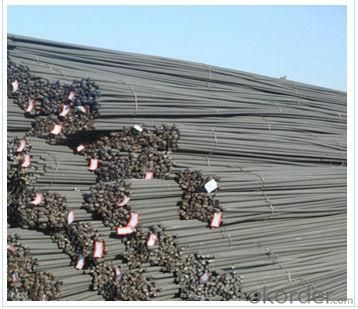
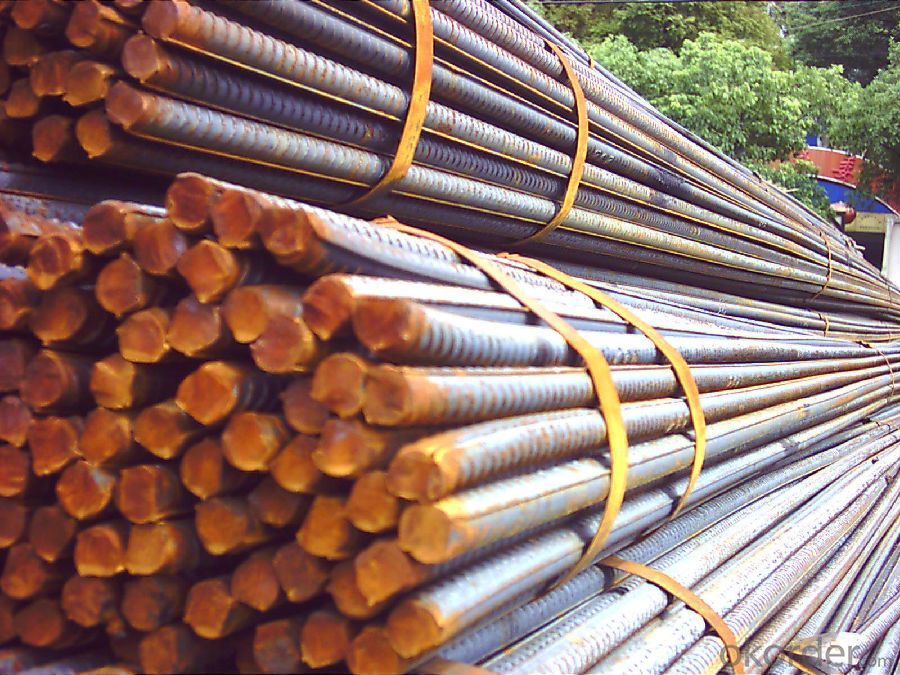
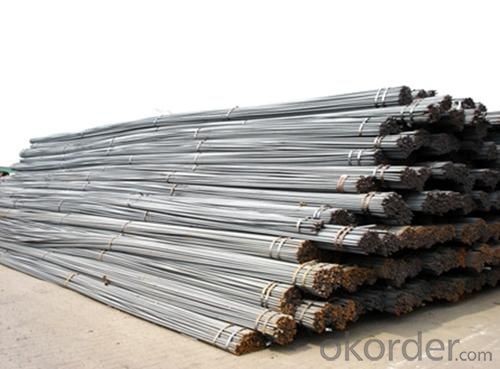
- Q: Are steel rebars resistant to fire?
- Yes, steel rebars are highly resistant to fire. The high melting point of steel makes rebars withstand extreme temperatures and maintain their structural integrity during a fire. Additionally, the presence of steel rebars in concrete structures can help prevent spalling, which is the breaking off of concrete due to high heat exposure.
- Q: How are steel rebars protected during transportation and storage?
- Steel rebars are protected during transportation and storage by being coated with anti-corrosion materials such as epoxy or zinc, and by being securely bundled and wrapped in waterproof covers or tarps to prevent exposure to moisture, dirt, and physical damage.
- Q: How do steel rebars perform in extreme weather conditions?
- Steel rebars perform well in extreme weather conditions. Steel is highly resistant to temperature changes, which helps maintain its strength and integrity. It can withstand high winds, heavy rain, and extreme cold without losing its structural stability. Additionally, steel rebars have excellent corrosion resistance, minimizing the risk of damage caused by moisture or salt exposure. As a result, steel rebars are a reliable choice for construction projects in areas prone to extreme weather conditions.
- Q: How are steel rebars protected from fire damage?
- Steel rebars can be safeguarded against fire damage using a variety of techniques. One commonly employed approach involves applying fire-resistant coatings to the rebars. These coatings are specifically formulated to endure high temperatures and prevent the steel from reaching its critical temperature, at which point its structural integrity would be compromised. Another method involves encasing the rebars in fire-resistant concrete. This specially designed concrete acts as a shield, impeding the direct transfer of heat to the steel rebars and thus safeguarding them from fire damage. Additionally, temporary protection for steel rebars during construction can be provided by using fire-resistant wraps or blankets. These wraps are crafted from materials that are resistant to fire and are directly applied to the rebars, creating a barrier that prevents direct exposure to fire. It is crucial to note that the level of fire protection necessary for steel rebars is contingent upon the specific building codes and regulations in place. These codes typically stipulate the minimum fire resistance rating that must be attained for structural elements, including rebars, in order to guarantee the safety of the building and its occupants.
- Q: What are the guidelines for protecting steel rebars during concrete placement and compaction?
- The guidelines for protecting steel rebars during concrete placement and compaction include ensuring that the rebars are clean and free from any rust, grease, or other contaminants. They should be properly tied and supported to maintain their position and prevent displacement during the concrete pouring process. Additionally, rebars should be adequately spaced to allow concrete to flow around them and provide sufficient cover, as specified in the design requirements. Care should be taken to avoid damaging the rebars during compaction, and vibrating equipment should be used cautiously to prevent excessive force or vibration that could cause rebars to shift or become dislodged. Regular inspections should be conducted to check for any damage or movement of the rebars, and necessary repairs or reinforcement should be done promptly to ensure the structural integrity of the concrete.
- Q: What are the different methods for cutting steel rebars on-site?
- Cutting steel rebars on-site can be achieved using various methods, which depend on the specific project requirements and limitations. The following are some commonly used techniques: 1. For smaller projects or areas where power tools are inaccessible, manual cutting proves to be a suitable method. Handheld manual tools like rebar cutters or bolt cutters are utilized to cut through the steel rebars. 2. Abrasive cutting, also known as grinding or cut-off saws, employs a high-speed rotating disc with abrasive particles that grind through the steel rebars. This method is effective for cutting rebars of different sizes and is frequently employed on construction sites. 3. Torch cutting involves the use of oxy-fuel or plasma torches. The method entails heating the steel rebars to a high temperature and then cutting through them using the intense heat. Torch cutting is ideal for thicker and larger rebars, although caution and safety measures must be observed due to the open flame involved. 4. Shear cutting utilizes hydraulic or mechanical shears to cut through the steel rebars. It is an efficient method for quickly and accurately cutting rebars, particularly for larger projects. 5. Hydraulic cutting involves the use of hydraulic pumps to generate high pressure, which is then utilized to power the cutting blade. This method is commonly employed for heavy-duty cutting tasks and can easily cut through thick rebars. 6. Electric cutting is achieved using electric cutters, such as electric rebar cutters or portable band saws. These tools are powered by electricity and provide a clean and precise cut. They are commonly utilized on construction sites where power is readily available. When selecting the appropriate method for cutting steel rebars on-site, it is crucial to consider the specific project requirements, including the size and thickness of the rebars, available power sources, and safety considerations.
- Q: What are the different grades of steel rebars available in the market?
- There are several grades of steel rebars available in the market, including Grade 40, Grade 60, and Grade 75. These grades indicate the minimum yield strength of the rebars, with Grade 40 having a yield strength of 40,000 pounds per square inch (psi), Grade 60 having a yield strength of 60,000 psi, and Grade 75 having a yield strength of 75,000 psi. The choice of grade depends on the specific application and structural requirements.
- Q: Can steel rebars be bent or shaped on-site?
- Yes, steel rebars can be bent or shaped on-site using specialized tools such as rebar benders or hydraulic benders. This allows the rebars to be customized and adjusted to fit the specific requirements of a construction project.
- Q: How do steel rebars affect the overall seismic performance of a structure?
- The overall seismic performance of a structure is greatly enhanced by steel rebars. Seismic events, like earthquakes, exert dynamic forces on buildings, causing them to vibrate and possibly collapse. However, incorporating steel rebars in concrete structures significantly enhances their ability to withstand these forces and ensures the safety of those inside. First and foremost, steel rebars strengthen a building's structure. By reinforcing the concrete, they increase its tensile strength since concrete alone is weak in tension. During an earthquake, the rebars help distribute the dynamic forces throughout the structure, preventing stress concentration in specific areas. This redistribution of forces minimizes the risk of localized failures and maintains the stability of the structure. Moreover, steel rebars improve the ductility of a structure. Ductility refers to a material's ability to deform under stress without breaking. During an earthquake, buildings undergo significant lateral movements and deformations. Steel rebars, with their high ductility, can elongate and stretch without fracturing, absorbing and dissipating the seismic energy. This property enables the structure to withstand larger ground motions and reduces the chance of sudden collapse. Furthermore, steel rebars enhance the overall resilience of a structure. Resilience refers to a building's ability to quickly recover its functionality after an earthquake. By reinforcing the concrete, steel rebars contribute to the post-earthquake repairability of the structure. They ensure that the building maintains its load-carrying capacity even after sustaining damage, which reduces downtime and allows for a faster recovery. Additionally, steel rebars serve as a warning sign for potential structural issues. During an earthquake, cracks may appear in the concrete, indicating areas of stress concentration. These cracks are often visible around the rebars, acting as an early indication of structural vulnerability. This visual warning allows for timely inspection and repair, preventing further damage and ensuring the long-term safety of the building. In conclusion, steel rebars play a crucial role in enhancing the overall seismic performance of a structure. Their inclusion in concrete greatly improves structural integrity, increases ductility, enhances resilience, and provides visual warnings of potential issues. By reinforcing the concrete, steel rebars ensure that buildings can withstand seismic forces, reducing the risk of collapse and ensuring the safety of occupants during earthquakes.
- Q: How do steel rebars affect the overall load distribution of concrete structures?
- The load distribution of concrete structures is critically influenced by steel rebars, which play an essential role. Reinforcement is provided by steel rebars, enhancing the overall strength and durability of the concrete. Concrete is strong in compression but weak in tension, which is counterbalanced by embedding steel rebars within it. This ensures a more even distribution of the load and helps prevent cracks and structural failures by absorbing and distributing tensile forces exerted on the concrete. The presence of steel rebars effectively transfers tension forces to the surrounding concrete as the load is applied to the structure. This mechanism of load transfer results in a more balanced distribution of forces throughout the structure. The steel rebars work in harmony with the highly compression-resistant concrete, preventing excessive deflection and maintaining the structural integrity of the overall system. This is particularly crucial in large-scale concrete structures like bridges, high-rise buildings, and dams, where careful load distribution is necessary for stability. In conclusion, steel rebars have a significant impact on the load distribution of concrete structures, reinforcing the concrete and enhancing its tensile strength. They work in partnership with the concrete to ensure an even distribution and transfer of the load, preventing cracks and structural failures. The combination of steel rebars and concrete creates a robust and dependable structural system capable of withstanding applied loads and ensuring long-term safety.
Send your message to us
GR40 deformed steel bar for construction made in China
- Loading Port:
- Tianjin
- Payment Terms:
- TT OR LC
- Min Order Qty:
- 25 m.t.
- Supply Capability:
- 100000 m.t./month
OKorder Service Pledge
OKorder Financial Service
Similar products
Hot products
Hot Searches
Related keywords
